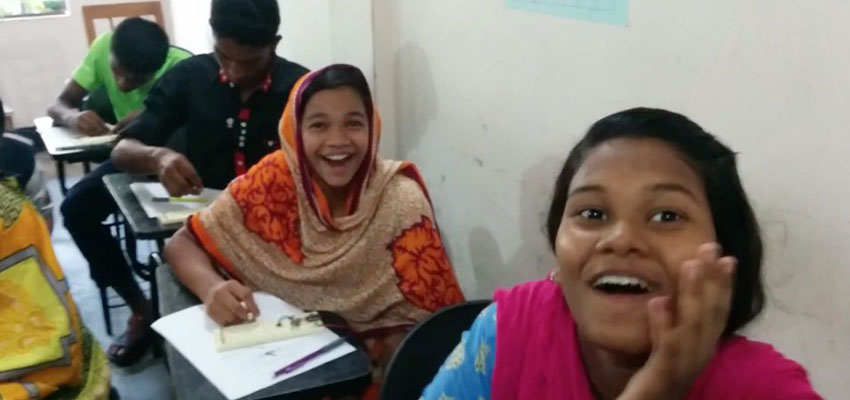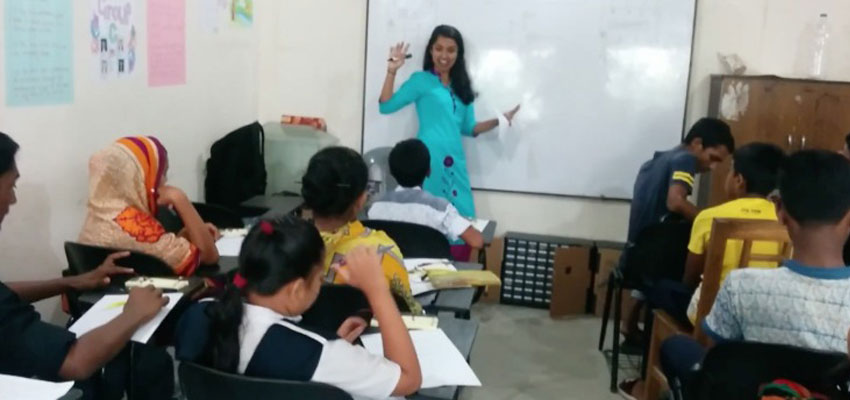
“Though the workshop had tangible outputs, the legacy of enthusiasm in the students, their desire to continue learning, and the infectious nature of their excitement towards electronics are much more important for the advancement of their community, and eventually of Bangladesh."
Motivation
In January of 2017, when I was teaching at ORT Yami School in Ashdod, Israel, I began to think seriously about the challenges of teaching youth abroad, especially teaching for students who are born with few opportunities. Since I have taught electronics to middle school, high school, and university students in the US, I was curious if I could effectively teach the same material – circuit design and construction – to middle school students from slums and villages in Bangladesh, my birth country. Though Bangladesh is home to my culture and comfort, I had not visited in seven years. When I began researching the state of education there, I was shocked by the data I found.
Context
Imagine taking half the US population and cramming them into the state of Georgia: that’s Bangladesh! Still, this picture of population density doesn’t take into account the amount of land rendered unlivable by annual flooding. It is in this densly populated country that, according to the World Bank (Oct 2016),1 only 4% of the workforce possesses a secondary education degree or higher. Furthermore, primary and secondary education dropout rates are quite high, with only 50% of students who enroll in first grade reaching tenth grade. “Around five million Bangladeshi children between the ages of six and 13 – mostly from poor families, urban slums, and hard-to-reach areas – remain out of school.” Still, the government of Bangladesh only spends 2.2% of its GDP on public education, compared to global education giants such as Norway, Sweden, and Switzerland, who spend 5 – 10% of their GDP on education.

Youth Electronics Program (YEP) 2017
The deficiencies in the Bangladeshi education system are enormous. Only with significant improvements to public policy regarding education as well as concentrated efforts to increase, firstly, access to education, and, secondly, quality of education, can these deficiencies be addressed.2 The purpose of my program was, thus, not to tackle the major educational issues in Bangladesh. Instead, I wished simply to spread my electronics knowledge with an inquiry-based teaching style. So, I took D-Lab: Education and Learning (EC.S07) in the spring of 2017 to learn about methods for effective teaching, especially for youth in developing countries. The most useful lessons I gleaned from EC.S07 were:
(1) methods for developing a classroom culture in order to acquire student trust and to construct a healthy environment for student-driven learning, and
(2) proper ways to ask questions and foster student collaboration on projects in order to employ inquiry-based hands-on learning
Using the skills and mindsets I acquired in D-Lab: Education and Learning, I taught a three-week electronics workshop in Bangladesh to sixth-grade students at JAAGO Foundation’s school in Rayer Bazaar, Dhaka, Bangladesh. The students that attend this school come from nearby slums. Their families do not have the ability to pay for their education. JAAGO gives these students education, books, uniforms, and, more important, a future, for free. During the workshop, the students learned the function of basic electronic components such as resistors, capacitors, photodiodes, and op-amps, and learned how to design circuits such as transimpedance amplifiers and bandpass filters. With their knowledge, they each built their very own heartbeat monitor circuit, which they were allowed to keep. At the end of the workshop, they got to showcase their creations and their newfound knowledge to the JAAGO’s founder, Korvi Rakshand, as well as to other faculty and staff.

Lessons Learned
The students I taught are brilliant, eager sponges. They soak up any knowledge you give them. They just need more people willing to provide the knowledge. Amartya Sen, Nobel Prize Winner of Economics, claimed that not providing education to all youth creates a massive waste of human potential.3 My observations affirmed this idea. I found it no more difficult to teach these students than to teach well-off American students. The sixth grade Bangladeshi students from slums in Dhaka learned electronics at roughly the same pace and understanding as ninth grade American students from Cambridge, Massachusetts. If these students had not received a free education from JAAGO, they would have many fewer opportunities and been able to contribute much less to society. They are just as capable as any other student of their age.
The students’ ability to learn so well and the sheer joy they exuded during the process of making their heartbeat monitors made my efforts more than worth it. Shafayet, one of my students, really made me smile when he said to me [translated from Bengali], “Farita Apu, when I explain it to these adults, they think it’s so much simpler than it actually is. If only they tried making it themselves, they would understand!” As I was leaving the school on my last day, I saw another one of my students, Limon, at a tiny shop in the area, demonstrating his heartbeat monitor to a shopkeeper and a few excited onlookers. I can’t help but hope the students will spread their knowledge and inspiration to others in their community while I’m gone. Though the workshop had tangible outputs, the legacy of enthusiasm in the students, their desire to continue learning, and the infectious nature of their excitement towards electronics are much more important for the advancement of their community, and eventually of Bangladesh.

Looking Forward
For a while, I have been wanting to undertake a long term project to start inquiry-based schools in Bangladesh and West Bengal, especially in slums and villages, where the literacy rate and educational attainment are lower than the national or regional average. I want to design a phase-in randomized controlled trial4 to test the effectiveness of increasing access to education while employing a specific type of pedagogy, specifically on students’ test scores, class attendance, creativity, and self-confidence. I also hope to expand this venture to connect working professionals with youth in Bengal as a project-based “tutoring” service, so that children can learn whatever they desire from experts in the field. YEP 2017 is just the first stepping-stone toward this goal.
--------------------------
1 "The World Factbook: BANGLADESH." Central Intelligence Agency. Central Intelligence Agency, 12 Jan. 2017. Web. 04 Feb. 2017.
2 Banerjee, A., Glewwe, P., Powers, S., and Wasserman, M. “Expanding Access and Increasing Student Learning in Post-Primary Education in Developing Countries: A Review of the Evidence.” Abdul Latif Jameel Poverty Action Lab (J-PAL), 09 April 2013. Web. 30 Sep. 2017.
3 “Amartya Sen Discusses Universal Primary Education with Host Mishal Husain.” PBS, Public Broadcasting Service, 4 Sept. 2003, www.pbs.org/wnet/wideangle/interactives-extras/interviews/time-for-schoo....
4 A randomized controlled trial is a type of study designed to reduce bias and is employed extensively by medical professionals to evaluate the effectiveness of drugs, and, more recently, by the Abdul Latif Jameel Poverty Action Lab (JPAL) to evaluate the effects of proposed policy changes, especially in developing countries.

